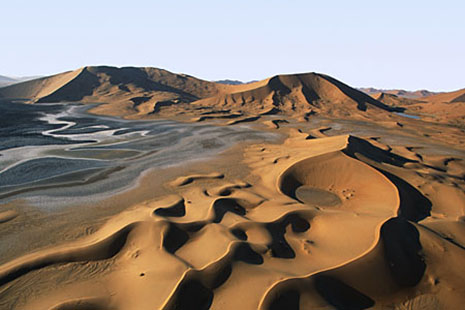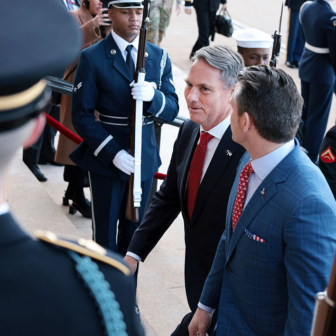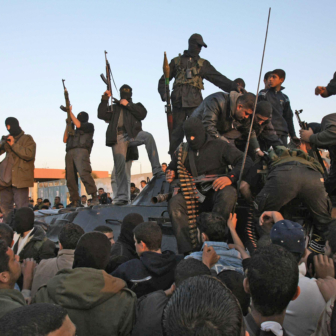Desert Kingdom: How Oil and Water Forged Modern Saudi Arabia
By Toby Craig Jones | Harvard University Press | $44.95
THERE is a story – perhaps apocryphal; the Arab world is full of such anecdotes – that just before the discovery of oil in Saudi Arabia in the early 1930s, King Saud was travelling through the countryside. He was approached by a poor village woman who begged him for some money for her family’s necessities. In those days, the king would carry cash around with him; taken aback by the woman’s plight, he handed her a bag of money. She was so overwhelmed that she fell to her knees and began an almost panegyrical blessing of the king. “Thank you, your majesty,” she said, “and may God bless you by opening up the bounty of the earth for you.” A year or so later, the story goes, oil was discovered in Saudi Arabia, and thus began the transformation of a harsh, barren environment into a modern, wealthy nation-state.
By this account, oil was a blessing, both literally and metaphorically, which helped make the country. But the reality has proved to be much more complex. We no longer believe that large “rental” incomes, especially from oil, are a simple positive. Oil may bring wealth, but it also brings currency problems, employment challenges, other economic maladjustments and, above all, problems of governance and foreign relations – which together are now routinely referred to as the “resource curse.” It isn’t surprising, therefore, that another story from Saudi Arabia, originating barely a generation later in the 1970s, has the former oil minister Sheikh Ahmed Yamani lamenting, “All in all, I wish we had discovered water instead.”
If nothing else, oil has given Saudi Arabia the world’s attention. It is a strategically important country producing around 12 per cent of the world’s most strategic commodity – and closer to a fifth of the world’s internationally traded oil – and sitting on top of almost a quarter of the world’s proven reserves of conventional oil. It is also an important gas producer and downstream manufacturer. No one – not the protesters who opposed the 2003 invasion of Iraq on the assumption that it was about American control of Iraqi oil (it was not) nor those who worry about the attention showered on corrupt or authoritarian Arab regimes by Western oil executives and politicians – disputes the fact that oil is central to the fortunes of Saudi Arabia and its neighbours.
Indeed it is. As a result, there has long been an interest, among scholars and observers covering oil and energy politics, in how oil shapes and influences political dynamics. Scholars have developed a range of theories applicable to modern Saudi Arabia. These include “rentier state” theory, which seeks to show that “allocative leaderships” are the reason why democracy so seldom takes hold in oil states, and theories such as neopatrimonialism, which argues that patron–client webs at the elite level explain the pattern of rule and durability in closed authoritarian systems. It is now common for lists of “the best books of the year on the Middle East” or suchlike to include several about Saudi Arabia. There is now a range of scholars who would qualify as true experts on Saudi Arabia and who have produced great works about it.
How things have changed. Until a decade or so ago, the kingdom had long been notorious for being an extremely difficult place in which to do research, whether academic or journalistic. It was very closed, and felt that way: requesting one of the scant academic or research visas from Saudi officials back in the 1970s, 1980s or 1990s was excruciating, most of all where the topic touched on politics. Even if one did gain entry, there was still the problem of building local networks and friendships to the point where people had enough trust to talk about the country openly.
Not that getting into Saudi Arabia has become easy, but at least some recent scholars have begun to spend significant time in the country and to back up their research with fieldwork, interviews, personal observations, and the anecdotes and insights that one only gets from an affiliation and affinity with a place and its people. As a result, the year 2010 was a bumper year for great books on Saudi Arabia. One was Steffen Hertog’s masterpiece, Princes, Brokers, and Bureaucrats: Oil and the State in Saudi Arabia. Hertog worked in Saudi Arabia and saw its public institutions from the inside, and it shows. This is bound to quickly become a classic in Middle Eastern studies and especially in the political economy of oil states.
Another book, also by an emerging expert, is Thomas Hegghammer’s Jihad in Saudi Arabia: Violence and Pan-Islamism since 1979, which is already the most extensive and thoroughly researched work on the evolution of al Qaeda in Saudi Arabia. But both books are very academic works: to those with only passing knowledge of Saudi Arabia and the more salient political theories on Arab politics, they will probably prove dense and heavy-going.
The third of these imposing new books about Saudi Arabia is Toby Craig Jones’s Desert Kingdom: How Oil and Water Forged Modern Saudi Arabia. Jones has much in common with Hertog and Hegghammer; each has a top academic pedigree, having graduated from top universities: Hertog’s doctorate is from Oxford, Hegghammer’s from Sciences Po and Jones’s from Stanford, and all three have based their books not only on rigorous scholarship but also on extensive fieldwork. Jones spent a year living in the country, attached to a university and conducting his research on the ground.
Of the three, Jones’s book will probably appeal most to the educated lay reader. It is analytical but engagingly written and not overly theoretical, perhaps because Jones is a historian rather than a political scientist. And yet despite its readability and engaging narrative, Jones’s book is just as insightful and academically original as the others – and may even be the most original of the three.
While almost all scholars of the Middle East would say that oil has been integral to defining modern Saudi Arabia, it is remarkable that none – at least since Sheikh Yamani’s comment in the 1970s – has looked in any detail at another natural resource, water, and its impact on modern Saudi history. Has it really eluded scholars that Saudi Arabia has not a single lake or river of any substance, and that its people would begin to die of thirst if the kingdom’s desalination plants were to fail? Apparently so. Desert Kingdom is the only study of any size or depth that places water side-by-side with oil in a study of twentieth-century Saudi Arabia.
Jones brings a unique line of argument to the debate about the modern political history of Saudi Arabia. He argues that the Saudi royal family governs and holds together a fragile state not merely because of oil revenue, important though that is, but also through careful management of both oil and water. At its core, his book argues that the regime controls natural resources, whether hydrocarbons or water, and that, in doing so, it gains control of the population.
THE Saudi state as we know it today is, of course, a fragmented and artificial creation. It was built by the al Saud family, yes, but only through complex arrangements. A diverse set of tribal groups were brought into the fold through marriage, coercion or the al Sauds’ use of the Ikhwan militia. These dynamics require a symbiotic arrangement with clerics, who otherwise could build a popular base and claim religious legitimacy, and the business community on the Red Sea coast, which otherwise could draw on its wealth to demand autonomy from the state. On top of that, of course, is the famous, or infamous, trade with the United States: energy security for Washington in return for protection against external threats for Riyadh.
Until now, the conventional wisdom has been that what held together the al Sauds’ bonds with other elites was symbiosis, or political quid pro quo, and that a number of factors underwrote the societal bonds necessary for the formation of a modern state and cohesive nation. These included tribal intermarriage by the royals and others, oil wealth and the selective but widespread allocation of riches across society, and the use of modern communications technologies and the apparatus of the state to build an artificial but genuinely imagined and shared Saudi community.
Jones takes us beyond these points. After all, the elite relationships that underpin the Saudi royals’ position explain some higher-level political bargains but say little about how the broader society was brought into the nation-building exercise. The argument that oil was crucial is not seriously contested by most observers – Jones agrees too – but the theories contending that al Saud rule is solely due to rent disbursements have not convincingly established a link with better state–society relations. Other theoretical approaches have demonstrated limitations as well.
Jones explains his argument about the joint importance of oil and water through a historical and analytical narrative alongside a selection of fascinating stories and examples. He opens the book with the wonderful story of Saudi plans in the 1970s to solve water supply problems by towing an iceberg from Antarctica to a Saudi port where it could be melted down into drinking water (yes, seriously). He shows how crucial water has been to Saudi economic development projects – both the successful ones and the white elephants – and in the process argues that such grand schemes helped bind the Saudis together in their national experiment, building a sense of national accomplishment and bringing people into the state’s economic and social influence.
His argument here is that such policies gave – and still give – the regime its political power. They not only tame nature, but also tame the population: by confirming the state’s importance in economic life; by building its legitimacy and binding people to its institutions through grand projects and new development opportunities; and by helping to develop and sustain the state as the bringer and giver of wealth, modernity, technology and opportunity. In this light, grand projects such as the development of a large, subsidised and expensive agricultural sector is not the madness it may seem; although it makes little sense through a purely financial lens, it makes perfect political sense.
Jones goes even further than this. He argues that the state grew smarter as oil wealth and the harnessing of water transformed the state–society relationship. The oil wealth paid for the projects that brought technology, skills and Western-style rationality, which in turn expanded the al Sauds’ experience with the complexities of modern governance and sharpened their political smarts. This is a novel argument, at least in the Saudi case, and adds originality and insight – if possibly some controversy – to the book’s strong factual base.
When all these dynamics are put together – the royals’ skills (and size – there are some 7000 princes embedded in the system, remember), the oil money, the big projects – it’s not surprising that Saudi Arabia’s regime is likely to be safe from the protests that removed the presidents of Tunisia and Egypt (and soon, possibly, Libya and Yemen). The Saudis don’t just have the repressive capability of these other leaders, they also have cooptive means and a wider elite web that would make most authoritarians jealous.
Non-specialist readers will find interesting historical discussion in Desert Kingdom. There is much here on the history of foreign firms in the Saudi oil industry, for example, and on the 1979 siege at Mecca and the Shiite uprisings in the eastern province the same year. Some of this covers well-trodden ground, but it is usually done with a fresh lens and a new angle to enliven the narrative for those more familiar with these events.
This is not to say that the book is without weaknesses, or at least some elements to be wary of, especially for readers who may be uninitiated in Middle East studies. Because the book focuses on Saudi Arabia’s eastern province, readers will need an interest in that area (or a willingness to learn something of it) and may find themselves having to extrapolate some points to the national level. Alternatively, they might want to read this book in conjunction with a broader work such as Madawi Al-Rasheed’s A History of Saudi Arabia or Robert Vitalis’s America’s Kingdom: Mythmaking on the Saudi Oil Frontier.
People may quibble with other things. The book lacks an introduction, even if much of what would be found in one is still there in the text. Annoyingly for scholars (and reviewers) it does not have a bibliography: while its citations are sufficient, it would be good to see more easily which texts were consulted, and to have at hand a list of interviewees (or at least some details of them).
But Desert Kingdom advances new ways of viewing Saudi Arabia, underpinned by new information. It may well stir some debates that could reshape how many observers see modern Saudi Arabia. It will certainly end up next to Hertog’s Princes, Brokers, and Bureaucrats and Hegghammer’s Jihad in Saudi Arabia in a list of classic works on Saudi Arabia, but ought also to find a wider readership among those willing to invest a little time and energy in a book that is quite specialised in scope, but much broader in its insights and its lessons. •




